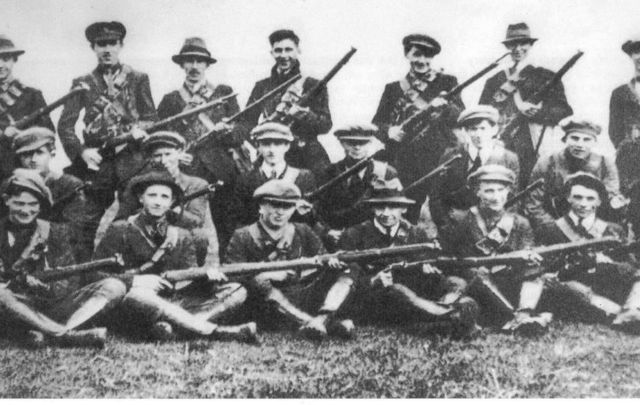An excerpt from Echoes of Their Footsteps, Volume I: The Quest for Irish Freedom by Kathleen Hegarty Thorne
By July 1920, Crown Forces were flooding the country. Volunteers who were known to the authorities risked life and limb to stay at home or to congregate in familiar places.
With so many men being sought by the Royal Irish Constabulary, Black and Tans, and British Army, the vulnerable Volunteers began banding together. Soon official Flying Columns were formed:
Kerry No.2 Brigade, Ballymacelligott, June 1920 (Tans, Terror and Troubles by T. Ryle Dwyer, p. 208)
East Limerick, July 1920 (The War of Independence in Limerick 1912−1921 by Thomas Toomey, pp. 375−378)
West Clare, August (Blood on the Banner by Pádraig Óg Ó Ruairc, p. 145)
The Cork No.2 Brigade Flying Column, formed at Mourneabbey, 7 August (“The only British Military Barracks captured by the IRA was at Mallow,” The Kerryman, 11 April 1964, p. 6)
Mid-Limerick and West Limerick Brigade Columns, August 1920 (The War of Independence in Limerick 1912−1921 by Thomas Toomey, pp. 428, 431)
South Roscommon/Athlone area, end of summer 1920 (Pat Lennon Witness Statement, p. 9.
East-Limerick Brigade was reorganised by Ernie O’Malley and Sean Wall. Members of a single Brigade Column were selected from all six Battalions, September 1920 (The War of Independence in Limerick 1912−1921 by Thomas Toomey, p. 425)
North Roscommon, September 1920; 1st Battalion South Roscommon in January 1921 (They Put the Flag a-Flyin’ The Roscommon Volunteers 1916−1923 by Kathleen Hegarty Thorne, pp. 67, 179)
Westmeath/Athlone Brigade, September/October 1920 (Witness Statement of Michael McCormack, p. 16) and (Witness Statement of Henry O’Brien, p. 10)
3rd Battalion South Roscommon, October 1920 (Witness Statement of Frank Simons, p. 14)
Tipperary, October 1920 (“Stirring Days with the Third Tipperary Brigade,” Nenagh Guardian, 30 August 1975, p. 4)
A second Tipperary Column formed in November 1920 (“Stirring Days with the Third Tipperary Brigade,” Nenagh Guardian, 30 August 1975, p. 4)
South Leitrim Brigade, December 1920 (Bernard Sweeney Witness Statement, p. 10)
Two Monaghan Columns, end of 1920 (Unsung Heroes by Kevin McGeough, p. 55)
East Mayo formed a Flying Column in December 1920 (Memories of an Old Man 1901−1986 by John Snee). (Sean Walsh in A History of the East Mayo Brigade 1913−1921 by James Reddiough [p. 44], claims the date as January 1921)
Donegal had a fulltime Flying Column by January 1921 that was led by Peadar O’Donnell (Donegal and the Civil War by Liam O Duibhir, pp. 24−25)
Mallow Flying Column in Cork (“I.R.A. Veteran Who Escaped Firing Squad,” Irish Independent, 21 October 1967, p. 9)
Tuam Battalion, North Galway, February 1921 (Pat Treacy Witness Statement, p. 5)
West Mayo Brigade, including Westport, Castlebar, and Newport Columns, amalgamated in the spring of 1921 (Raids and Rallies by Ernie O’Malley, p. 160)
A second Kerry No.2 Brigade Flying Column, 2 March 1921 (Tans, Terror and Troubles by T. Ryle Dwyer, p. 281) and (“A Bitter War of Chance, Courage and Brutal Death,” The Kerryman, 26 August 1994, p. 26)
East Waterford, late May 1921 (Witness Statement of P. J. Paul, p. 35)
When these Flying Columns were based in a particular area, it was not uncommon for the local IRA to act as scouts and security guards and provide them with food and clothing when necessary.
Roving bands of Volunteers was a game-changer in the strategies of the Irish War of Independence. Face-to-face military confrontations on open battlefields were deemed a fool's errand. Hit and run became the order of the day. Members of Flying Columns waited in ambush, robbed trains of British supplies, attacked the nearby military barracks to obtain badly-needed guns, raided the mails to determine who was secretly communicating with Dublin Castle, and, most important, provided a moving target that was difficult for battalions of enemy soldiers to track and contain.
Quote: "I stuck my sandwiches in one pocket of my coat, the bullets in the other, and my rifle down my pants, got on my bicycle and went off to declare war on the British Empire. And you know what? In the end, we beat 'em."
-Spoken by John O'Callaghan, a detainee in Frongoch, as cited in Dublin in Rebellion A Directory 1913-1923 by Joseph E. A. Connell Jr., p. 398.

Love Irish history? Share your favorite stories with other history buffs in the IrishCentral History Facebook group.
This article was submitted to the IrishCentral contributors network by a member of the global Irish community. To become an IrishCentral contributor click here.




Comments